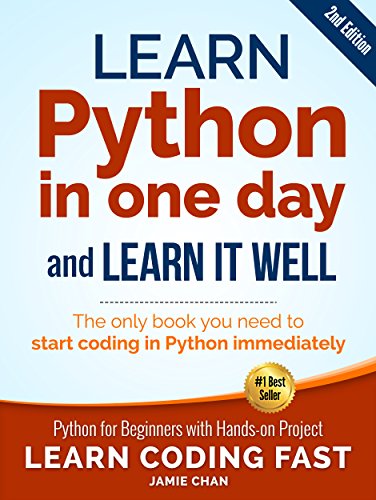12 best books on pythons
Here are some notable Python books:
"Python Crash Course" by Eric Matthes:
- This book is an excellent choice for beginners who want to learn Python for programming and automation.It covers the basics of Python programming and introduces you to various applications of Python in the tech industry.
"Automate the Boring Stuff with Python" by Al Sweigart:
- Al Sweigart's book focuses on using Python to automate everyday tasks. It's a practical guide that helps you write Python scripts to streamline your work and increase productivity.
"Python for Data Analysis" by Wes McKinney:
- If you're interested in data science and data analysis with Python, this book is a must-read. It covers data manipulation, visualization, and analysis using Python libraries like Pandas and Matplotlib.
"Fluent Python" by Luciano Ramalho:
- For those who want to deepen their Python skills, this book explores the nuances of the language. It delves into Python's features and best practices, making it suitable for intermediate to advanced programmers.
"Django for Beginners" by William S. Vincent:
- If you're interested in web development with Python, this book introduces you to Django, a popular web framework. It provides a step-by-step guide to building web applications using Python and Django.
"Python Cookbook" by David Beazley and Brian K. Jones:
- This book is a collection of recipes that cover a wide range of Python programming topics. It's a valuable resource for solving specific problems and improving your Python programming skills.
"Deep Learning" by Ian Goodfellow, Yoshua Bengio, and Aaron Courville:
- For those interested in machine learning and deep learning, this comprehensive book provides a deep dive into the concepts and practical implementations of deep neural networks using Python.
These books cover various aspects of Python in the fields of computer science and technology, catering to both beginners and experienced programmers. Depending on your specific interests and goals, you can choose the one that suits you best.
Below you can find our editor's choice of the best books on pythons on the marketProduct features
More about this book
So, naturally you are excited about Machine Learning and would love to join the party! Perhaps you would like to give your homemade robot a brain of its own? Make it recognize faces? Or teach it to walk around? Or maybe your company has tons of data (user logs, financial data, production data, machine sensor data, hotline stats, HR reports, etc.), and you could likely unearth some hidden gems if you just knew where to look. With Machine Learning, you could accomplish the following:
Product features
What's new in this third edition?
Many readers have told us how much they love the first 12 chapters of the book as a comprehensive introduction to machine learning and Python's scientific computing stack. To keep these chapters relevant and to improve the explanations based on reader feedback, we updated them to support the latest versions of NumPy, SciPy, and scikit-learn.
One of the most exciting events in the deep learning world was the release of TensorFlow 2. Consequently, all the TensorFlow-related deep learning chapters have received a big overhaul. Since TensorFlow 2 introduced many new features and fundamental changes, we rewrote these chapters from scratch. Furthermore, we added a new chapter on Generative Adversarial Networks, which are one of the hottest topics in deep learning research, as well as a comprehensive introduction to reinforcement learning based on numerous requests from readers.
What are the key takeaways from your book?
Machine learning can be useful in almost every problem domain. We cover a lot of different subfields of machine learning in the book. My hope is that people can find inspiration for applying these fundamental techniques to drive their research or industrial applications. Also, using well-developed and maintained open source software makes machine learning very accessible to a wide audience of experienced programmers, as well as those who are new to programming.
Python Machine Learning Third Edition is also different from a>emphasis on practical code examples. However, I think this approach is highly valuable for both students and young researchers who are getting started in machine learning and deep learning. We heard from readers of previous editions that the book strikes a good balance between explaining the broader concepts supported with great hands-on examples, giving a light introduction to the mathematical underpinnings.
Why is it important to learn about GANs and reinforcement learning?
The first GANs paper had just come out two years before we started working on the second edition, but we weren't sure of its relevance. However, GANs have evolved into one of the hottest and most widely used deep learning techniques. People use them for creating artwork, colorizing and improving the quality of photos, and to recreate old video game textures in higher resolutions. It goes without saying that an introduction to GANs was long overdue.
Another important machine learning topic not included in previous editions is reinforcement learning, which has received a massive boost in attention recently. Thanks to impressive projects such as DeepMind's AlphaGo and AlphaGo Zero, reinforcement learning has received extensive news coverage. And just recently, it’s been used to compete with the world's top e-sports players in the real-time strategy video game StarCraft II. We hope that our new chapters can provide an accessible and practical introduction to this exciting field.
Latest Reviews
View all
Piano Music Books
- Updated: 07.07.2023
- Read reviews

Kitchen Stoves
- Updated: 14.07.2023
- Read reviews

Skip Hop Baby Gyms
- Updated: 09.05.2023
- Read reviews

Powersports Brake Rotors
- Updated: 05.03.2023
- Read reviews

Strollers
- Updated: 22.03.2023
- Read reviews











